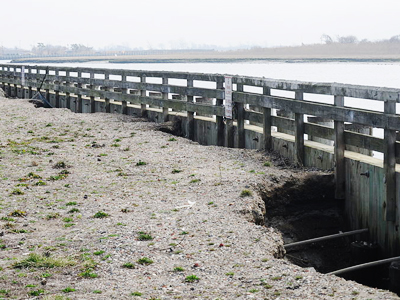Prof. Culligan and Team Win $3M Grant to Study NYC Coastal Sustainability
Patricia Culligan, professor of civil engineering and engineering mechanics, is leading a team of 20 investigators who have just won a five-year $3 million grant from the National Science Foundation (NSF) to study how urban green infrastructure (GI) can mitigate the city's role in coastal zone pollution. The award is one of only 11 grants—totaling $13.1 million—given by the NSF as part of its new coastal sustainability program. These are the first Science, Engineering, and Education for Sustainability (SEES) awards to fund studies of coasts in the U.S. and around the world.

Erosion along the shoreline, Waterfront Park, Freeport, Long Island
“We are thrilled to be included in the first wave of these significant coastal sustainability grants,” says Culligan, who is also the associate director of Columbia’s Institute for Data Sciences and Engineering and the co-Director of the Earth Institute’s Urban Design Lab. “More than half the world's human population lived in coastal areas in 2000, and that percentage is expected to rise to 75 percent by 2025. The environmental health of coastal areas is thus of key importance to the health and well-being of people around the globe. Discharge of wastewater and stormwater runoff from coastal cities is the dominant source of coastal zone pollution, and the built-up nature of modern cities only exacerbates this problem by increasing runoff from city surfaces, triggering combined sewer overflow events in cities with single-pipe wastewater conveyance systems, like New York, and intensifying urban flooding.”
Culligan’s team is concentrating on developing high-performance green infrastructure (GI) to mitigate coastal zone pollution and flooding, with a focus on the Bronx River Sewershed in New York City as their living test bed. “The New York State Department of Environmental Conservation and New York City are proposing to collaborate on a $2.7 billion investment in GI over the next two decades, so this grant is particularly timely,” says Culligan. “We hope the results of our work can help inform strategies for this investment to have maximum impact.”
She is working with an interdisciplinary team at Columbia that includes Richard Plunz (Professor, Graduate School of Architecture, Planning and Preservation and Director of the Urban Design Lab), Mark Becker (Senior Staff Associate, Center for International Earth Science Information Network), Wade McGillis (Lamont Associate Research Professor, Lamont-Doherty Earth Observatory), and Michael Gerrard (Andrew Sabin Professor of Professional Practice, Columbia Law School). The team also includes researchers at Barnard College and Drexel University, as well as community groups, government agencies, and industry partners engaged in implementing and overseeing New York City’s GI program.
Culligan notes that many coastal cities, including New York, Seattle, and San Francisco, are turning to urban green infrastructure to mitigate the city's role in coastal zone pollution. Urban GI, such as green roofs, green streets, advanced street-tree pits, rainwater gardens and bio-swales, introduces vegetation and permeability back into city landscapes, thereby reducing the volume and pollutant loading of urban runoff. Urban GI also benefits coastal city sustainability. For example, she points out, increasing vegetation and perviousness within city boundaries can help cool urban environments, trap harmful air-borne particulates, increase biodiversity, and promote public health and well-being.
But most current urban GI programs still focus on achieving volume reduction of storm water through passive detention and retention of rainfall or runoff. Holistic approaches to GI design that consider multiple sustainability goals are rare, Culligan notes, as is the use of advanced technology to control GI performance. “And how city inhabitants view, interact with, and value GI is little studied or accounted for in current urban GI programs,” she adds. “This project will develop and test a new framework for the next generation of urban GI that exploits the multi-functionality of GI for coastal city sustainability, builds a platform for real-time monitoring and control of urban GI networks, and takes account of the role of people and community in GI stewardship and long-term functionality.”
The team has expertise in a broad range of areas, from civil and environmental engineering, environmental science, and plant science/horticulture to urban planning and design, climate science, data science, environmental microbiology, environmental law and policy, inter-agency coordination, community outreach, and citizen science. “Coastal systems are critical to some of the world’s most populated areas,” Culligan adds, “and these grants will lead to better management of coastal environments and elevate green infrastructure performance to the next level.”
